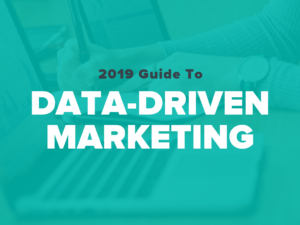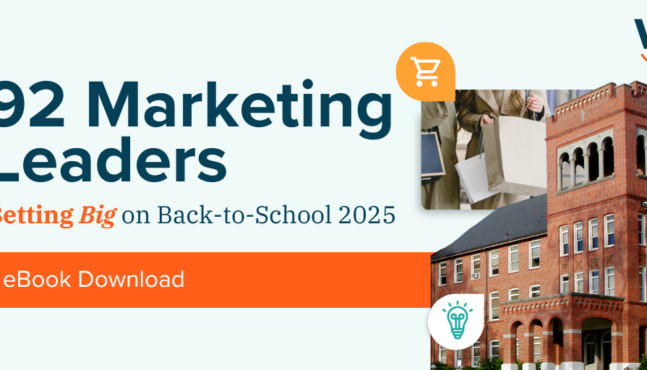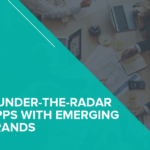
2019 Guide to Brilliant Data-Driven Marketing
Who are you selling to? What topics resonate with them? Where do they go to get information on those topics? What types of content do they like to consume?
If you can’t answer those questions with some certainty, there’s a good chance your marketing strategy is about as effective as a guessing game.
There’s a better way, and it’s called data-driven marketing.
What Is Data-Driven Marketing?
Data-driven marketing is the process of monitoring trends, collecting and analyzing data about your audience, and using the insights gained to make educated marketing decisions informed by cold, hard numbers.
Instead of educated guesses about their audience, data-driven marketers have actionable insight into who, what, where, when and how — who they’re trying to reach, the most effective platform and time to reach them, and the message and format that’s likely to resonate most.
Benefits of Data-Driven Marketing
The biggest benefit of data-driven marketing is that it helps you create better, more effective campaigns that drive more ROI for your organization. How does it do that? Let’s take a look at a few key ways:
Personalization
Perhaps the biggest benefit of using data to drive marketing is the ability to create highly personalized, highly targeted campaigns. Gone are the days of one-size-fits-all marketing messages. The more data you have about your customers, the more targeted you can make your campaigns.
According to research by McKinsey, “personalization can deliver five to eight times the ROI on marketing spend, and can lift sales by 10% or more.”
Improved Customer Experience
Forbes found that 49% of brands use data analytics to enhance the customer experience. One key way to do that is by personalizing their experience. According to one study, 80% of consumers are more likely to make a purchase when brands offer personalized customer experiences. When you have greater insight into your customers and what they value, you can offer the personalized experience customers expect.
Know What’s Working
Part of adopting a data-driven approach to marketing is carefully testing, tracking, and continuously improving your campaigns. This lets you know where your time and budget is best spent.
Predict the Future
By collecting and analyzing data on your customers’ behavior you can predict which calls-to-action and marketing messages will get them to buy in the future. Sales intelligence tools like Winmo take it a step beyond, predicting which specific companies and leads are likely to purchase, and when.
Challenges of Data-Driven Marketing
While a data-driven approach can improve your marketing, it’s not without its challenges. Some of these include:
You don’t have support from leadership. In a study by McKinsey on data and analytics programs, perhaps the biggest hurdle was a lack of leadership support and communication. Companies that had the most success tended to cite senior-management involvement as the factor that most contributed to their success.
Your data is obsolete or low-quality. Data is constantly changing. Your data needs to be constantly updated to provide a complete and accurate picture of your audience. It’s not the amount of data you have that’s most important — it’s the quality.

Data-driven personalization is hard. According to eMarketer, multiple studies have found that using data to personalize their messaging is one of their top challenges marketers face. The biggest challenges tended to be a lack of time, money or people. Not having the customer data needed to properly segment was another key challenge.

Via eMarketer
Hyper-focusing on data could lead to less creative campaigns. As Robert Glazer writes at Convince & Convert, a laser focus on metrics can come at the expense of outside-the-box thinking. Ideally, data and creativity should work together. All the data in the world can’t make up for bad creative!
You need the right skills. Collecting, analyzing, and using data can be quite a technical job (there’s a reason the field is called data science!) You don’t have to become a data scientist to use data-driven marketing (though you may find your team would benefit from hiring one.) But you and your team will likely need to learn some new skills in order to make the most effective use of your data.

Your data is siloed. Your data should be shared across the organization. Integrated data gives you a more complete view of your customer, particularly key for teams that use account-based marketing, and facilitates collaboration.
8 Data-Driven Marketing Tools to Add to Your Stack
The right tools can go a long way towards helping you overcome many of these challenges. Here are some of the top tools data-driven marketing teams are using.
- Google Analytics – A crucial tool in any marketing stack, Google Analytics gives you the data you need about your website visitors, their behavior, and demographics.
- Optimizely – Optimizely is an experimentation platform used by marketing and product teams to test, optimize and deploy effective products and customer experiences.
- HubSpot – The leader in inbound marketing, HubSpot offers a suite of powerful marketing, sales, email, customer service, CRM and analytics tools.
- Salesforce – The world’s #1 CRM, Salesforce’s helps companies manage marketing, sales, commerce, and service in one integrated cloud-based platform.
- SEMRush – This popular SEO tool helps businesses get data about their audiences and competition. SEMRush features include keyword research, website analysis and monitoring, competitor research and ad campaign optimization.
- Adbeat – Used by advertisers, agencies and ad networks, Adbeat helps companies analyze competitors’ advertising strategies and optimize their own.
- StatSocial – StatSocial helps brands and publishers analyze, segment and target social media audiences.
- Winmo – Winmo is a sales intelligence platform that uses predictive technology to help sales teams forecast opportunities, track industry trends and discover better leads, faster. Winmo also helps connect your data, with integrations to a number of other key tools, including Salesforce, HubSpot, SEMRush, Adbeat and StatSocial.
What Data Should You Collect?
To build a complete view of your customer, you should aim to collect several different types of data. These might include:
- Basic details like name and email address
- Demographic details like age, gender, race and education level
- Family details including marital status and number of children
- Geographic location
- Financial details — personal and household income, disposable income, home value
- Industry and profession, including organization structure and time in role
- Online behavior including visits to your website, content consumed
- Purchase history, referrals, Net Promoter Score
- Social media profile information and behavior
- Personality insights, such as Crystal Knows, to tailor outreach for maximum impact
- Media spend behavior to specify where marketing dollars are going
All of these data points and others together create a highly detailed customer profile, allowing you to build personalized, targeted, and highly relevant campaigns and marketing messages.
Data-Driven Marketing Examples
So what does data-driven marketing actually look like? Here are some examples of data-driven marketing tactics you might incorporate into your strategy.
Leverage Retargeting
This is a big one. If you know someone has shown interest in your product — or has even already made a purchase — it only makes sense to leverage that! You can offer ads that are relevant to the purchase they previously made or the product they looked at, to upsell or cross-sell another item.
Target Your Email Campaigns
For a decade now, email has consistently been the channel that delivers the best ROI for digital marketers. A data-driven approach, in which you carefully segment your audience to deliver the most relevant, personalized campaigns can improve the effectiveness of your email campaigns even more.

Via Campaign Monitor
Plan More Effective Campaigns
Demographic data can help you plan more effective campaigns. In one example, shared by Wordstream, lawn care company GreenPal optimized their Adwords campaign after discovering one neighborhood seemed particularly price-sensitive.
Said owner Bryan Clayton: “So we segmented those zip codes and only ran a specific ad for them, with the headline ‘The Cheapest Lawn Mowing in Nashville. Lawn mowing from $20… We then created a matching landing page. After running the ad for one month, on-page analytics proved the guess to be true. We saw over 200 percent lift in click-through rate and a 30 percent lift in on-page conversion.”
Create Targeted Landing Pages
As seen in the example above, you can use data to create multiple targeted landing pages that speak to individual segments of your customer base. Every customer won’t be interested in every product or feature you offer however a relevant landing page that focuses on one solution or aspect of your product that each segment is interested in can lead to greater conversions.
Monitor Industry Trends and Competition
Data-driven marketing doesn’t just let you get a better look at your customer — it can also help you “spy” on your competition. What’s working (or not working) for them? What industry shifts are coming down the pike? Who just got new funding or launched a new product? Use your findings to build your own strategy.
Winmo’s integration with digital display intelligence platform Adbeat pulls competitive reports showing which brands are advertising with your competition, and also allows you to set up alerts in order to keep an eye on them. Adbeat crawls eight million ads daily, connecting those placements to the brands who bought them, (and how much they spent), any ad networks they were routed through, and the publisher destinations they appeared on.
The Future of Data-Driven Marketing: 3 Trends to Watch in 2019
Data-driven tactics have been perhaps the biggest shift in the marketing industry in decades. So what does the future hold? These are the trends we’re watching.
1. Artificial Intelligence (AI) and Machine Learning
According to Salesforce, the average marketing organization currently uses 14 data sources. That number is expected to grow about 20% year-over-year. Making sense of that data, including creating personas, lists, and segments will increasingly be the job of artificial intelligence.
2. Privacy
The Cambridge Analytica scandal and GDPR have changed the marketing game. Even as customers respond to and want personalized messaging, they also increasingly report that retargeting and highly relevant ads are “creepy.” Brands will have to strike a careful balance with messaging and ensure that they have the legal permission they need.
3. Predictive analytics
One trend we’re particularly excited about is predictive analytics. Predictive analytics technology uses high-quality data points to zero in on companies and prospects that fit your customer profile, combined with “intent data” to determine which accounts are most likely to buy, and when. You can then use this data to build targeted ad campaigns, as well as have your sales team send their pitches to the right person at the right time.
The Bottom Line
These days reaching customers, closing sales, and beating out your competition requires a highly targeted and personalized approach. The solution is to use data to drive your marketing campaigns.
Set your goals, layout your strategy, and invest in the right tools to find, analyze and act on the data you need. Track your results and be prepared to “fail fast” and adapt as you go.
Looking for a sales intelligence platform to level-up your data-driven sales and marketing? Check out Winmo.





